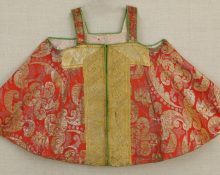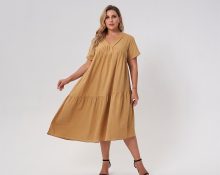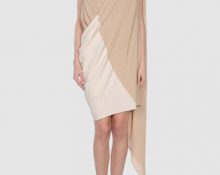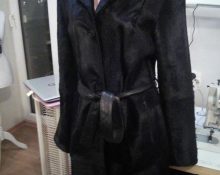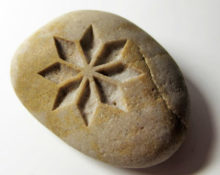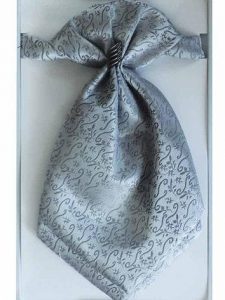
creativecommons.org
The plastron is the ancestor of the modern tie. Today, men wear it to costume balls, reenactments or themed weddings. In this material we will tell the history of this unusual wardrobe element, and also demonstrate how you can sew a plastron with your own hands. At the end of the article you will find recommendations for choosing fabrics for plastron, as well as examples of patterns.
History of ties and plastron
The first prototypes of ties appeared in the times of Ancient China, approximately in the 2nd century BC. Our contemporaries know about this thanks to the fact that the first emperor of the powerful united Qin Empire, the cruel Shihuang Di, decided to prepare a tomb for himself and ordered the creation of a terracotta army that would protect him after death and obey his orders.On the necks of these terracotta warriors (by the way, the face of each soldier out of nine thousand figures is unique and probably has its own prototype) there were ties resembling ties.
The first European prototypes of ties date back to a much later date, the 1st century AD. Neck bands were popular among Roman legionnaires. For a long time, ties were forgotten or used exclusively for military equipment. But in the 1620s, during the 30 Years' War, the French king meets with Croatian mercenaries, sees their uniform with traditional ties and orders the French nobility to adopt this accessory and wear it to royal meetings. By the way, the very name of this tie, La Cravat, translates as “Croatian”. This accessory is still known today and is called a cravat. The plastron is considered one of the variants of the cravat tie. But unlike its original, the plastron became widespread in Europe much later, in the 19th century, when men from the upper classes wore it to social events and balls.
It is curious that the word plastron itself began to be used in the Middle Ages. Then, by plastron they meant the chest plate of knights, attached to a warrior’s armor for additional protection. The word “plastrone” is still preserved in modern French, which translates as “armor breastplate” or “fencer’s breastplate”.
Unlike its predecessor, the cravat tie, the plastron is more comfortable and puts less pressure on the throat. If the cravat was made from linen, then for the plastron the seamstresses used gray or black silk. The plastron was folded in half and secured around the neck with pins or special clamps. It would seem that if an accessory is inconvenient, you can easily discard it.But it wasn't that simple. There was a long period when ties were considered a mandatory accessory and it was indecent to appear without them in society. This fact is confirmed by the rather weighty book by Honore de Balzac, “The Art of Wearing a Tie,” where the writer describes in detail all types of ties and scarves, as well as methods of tying them.
Types of plastron ties
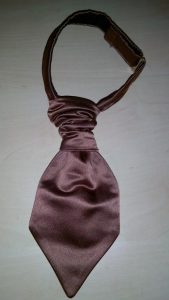
creativecommons.org
Plastrons are divided into several subtypes with the conventional names shirt-front, tie, necklace. The only thing they have in common is that they all cover part of the chest. In terms of origin, method of wearing and appearance, they differ quite strikingly, although they have a common name. The plastron dickey appeared at the beginning of the 19th century. The name itself suggests that the cunning tie had a dual purpose: on the one hand, it helped the owner to maintain decorum and look like he was wearing a tie, on the other hand, it replaced a shirt under a tailcoat, covering the neckline of a tuxedo. Thus, the shirtfront helped its owner save a significant portion of money. Today, the plastorn shirt is practically not used. Another subtype of plastron, a tie, looked like a wide neckerchief with narrow pointed ends. Usually it was worn by threading it into a special ring or pinned with pins. Today, a tie is also popular, but most often it is simply tied, without unnecessary accessories. The plastron necklace looks like a wide collar and is more reminiscent of the precious collars with decorations worn by the pharaohs during the times of Ancient Egypt (where, in fact, this look takes its roots). However, modern plastron necklaces are made of lightweight materials and decorated with rhinestones.Sometimes such necklaces are made of plastic or light metals, such as jewelry alloy.
Plastron today
Nowadays, more and more European grooms remember the old tradition and wear a plastron for the celebration. Today, this type of tie has become one of the most interesting details of a business card suit. Traditionally, suits are chosen in gray, dark gray, brown, pearl gray tones, and the plastron is made of white or beige silk. The plastron is convenient because it will not flutter in the wind or squeeze the throat too much, and if sauce drips on it, the plastron can be quickly replaced with a spare one. The plastron is also suitable for any other social event or even a ball. The modern plastron does not need to be tied - most often it has ties at the back (or even an elastic band), and the front knot or bow remains statically tied.
What is needed to sew a plastron
- Standard pattern provided by us.
- Thick silk cut. As an alternative, you can use a traditional tie material called silk duchess.
- Sewing supplies (thread, scissors, needle, chalk for marking).
Step-by-step master class on sewing a plastron
Silk fabric looks impressive, but if you are a beginner, it is better to choose a less slippery material.
- Iron the fabric.
- Fold it in half with the right side facing inward.
- Place the pattern on the fold line.
- Trace the pattern and duplicate the outline left for seam allowances.
- The length of the product can be adjusted during operation. It's better to add more length.
- Fold seams and finish seams.


 0
0